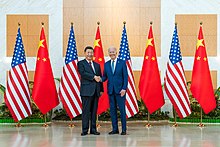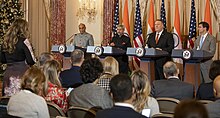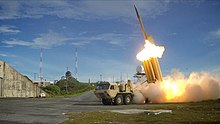The term One China may refer, in alphabetical order, to one of the following:

The relationship between the People's Republic of China (PRC) and the United States of America (USA) has been complex and at times contentious since the establishment of the PRC and the retreat of the government of the Republic of China to Taiwan in 1949. Since the normalization of relations in the 1970s, the US–China relationship has been marked by numerous perennial disputes including the political status of Taiwan, territorial disputes in the South China Sea, and more recently the treatment of Uyghurs in Xinjiang. They have significant economic ties and are significantly intertwined, yet they also have a global hegemonic great power rivalry. As of 2023, China and the United States are the world's second-largest and largest economies by nominal GDP, as well as the largest and second-largest economies by GDP (PPP) respectively. Collectively, they account for 44.2% of the global nominal GDP, and 34.7% of global PPP-adjusted GDP.
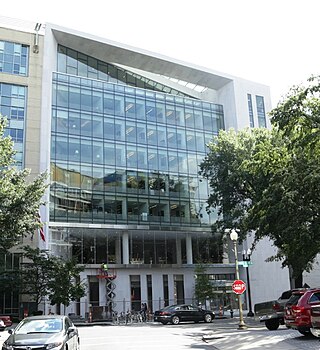
The Center for Strategic and International Studies (CSIS) is an American think tank based in Washington, D.C. From its founding in 1962 until 1987, it was an affiliate of Georgetown University, initially named the Center for Strategic and International Studies of Georgetown University. The center conducts policy studies and strategic analyses of political, economic and security issues throughout the world, with a focus on issues concerning international relations, trade, technology, finance, energy and geostrategy.

Shinzo Abe was a Japanese politician and statesman who served as Prime Minister of Japan and President of the Liberal Democratic Party (LDP) from 2006 to 2007 and again from 2012 to 2020. He was the longest-serving prime minister in Japanese history, serving for almost nine years in total. Abe also served as Chief Cabinet Secretary from 2005 to 2006 under Junichiro Koizumi and was briefly the opposition leader in 2012.
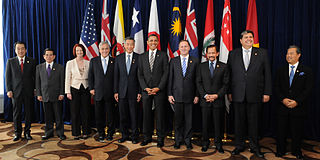
The Trans-Pacific Partnership (TPP), or Trans-Pacific Partnership Agreement (TPPA), was a proposed trade agreement between 12 Pacific Rim economies: Australia, Brunei, Canada, Chile, Japan, Malaysia, Mexico, New Zealand, Peru, Singapore, Vietnam, and the United States. In the United States, the proposal was signed on 4 February 2016 but not ratified as a result of significant domestic political opposition. After taking office, the newly elected President Donald Trump formally withdrew the United States from TPP in January 2017, therefore ensuring the TPP could not be ratified as required and did not enter into force. The remaining countries negotiated a new trade agreement called Comprehensive and Progressive Agreement for Trans-Pacific Partnership, which incorporated most of the provisions of the TPP and which entered into force on 30 December 2018.
The Taiwan Miracle or Taiwan Economic Miracle refers to Taiwan's rapid economic development to a developed, high-income country during the latter half of the twentieth century.

Victor D. Cha is an American political scientist.

After the United States established diplomatic relations with the People's Republic of China (PRC) in 1979 and recognized Beijing as the only legal government of China, Taiwan–United States relations became unofficial and informal following terms of the Taiwan Relations Act (TRA), which allows the United States to have relations with the Taiwanese people and their government, whose name is not specified. U.S.–Taiwan relations were further informally grounded in the "Six Assurances" in response to the third communiqué on the establishment of US–PRC relations. The Taiwan Travel Act, passed by the U.S. Congress on March 16, 2018, allows high-level U.S. officials to visit Taiwan and vice versa. Both sides have since signed a consular agreement formalizing their existent consular relations on September 13, 2019. The US government removed self-imposed restrictions on executive branch contacts with Taiwan on January 9, 2021.
The String of Pearls is a geopolitical hypothesis proposed by United States political researchers in 2004. The term refers to the network of Chinese military and commercial facilities and relationships along its sea lines of communication, which extend from the Chinese mainland to Port Sudan in the Horn of Africa. The sea lines run through several major maritime choke points such as the Strait of Mandeb, the Strait of Malacca, the Strait of Hormuz, and the Lombok Strait as well as other strategic maritime centres in Somalia and the littoral South Asian countries of Pakistan, Sri Lanka, Bangladesh, and the Maldives.

Michael Paul Pillsbury is a foreign policy strategist, author, and former public official in the United States. He is a senior fellow for China strategy at The Heritage Foundation and has been Director of the Center on Chinese Strategy at the Hudson Institute in Washington, D.C., since 2014. Before Hudson, he held various postings in the U.S. Department of Defense and U.S. Senate. He has been called a "China-hawk", and an "architect" of Trump's policy towards China. In 2018, he was described by Donald Trump as the leading authority on the country.
U.S. President Barack Obama's East Asia Strategy (2009–2017), also known as the Pivot to Asia, represented a significant shift in the foreign policy of the United States since the 2010s. It shifted the country's focus away from the Middle Eastern and European sphere and allowed it to invest heavily and build relationships in East Asian and Southeast Asian countries, especially countries which are in close proximity to the People's Republic of China (PRC) either economically, geographically or politically to counter its rise as a rival superpower.
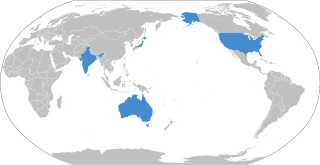
The Quadrilateral Security Dialogue (QSD), commonly known as the Quad, is a strategic security dialogue between Australia, India, Japan and the United States that is maintained by talks between member countries. The dialogue was initiated in 2007 by Japanese Prime Minister Shinzo Abe, with the support of Australian Prime Minister John Howard, Indian Prime Minister Manmohan Singh and U.S. Vice President Dick Cheney. The dialogue was paralleled by joint military exercises of an unprecedented scale, titled Exercise Malabar. The diplomatic and military arrangement was widely viewed as a response to increased Chinese economic and military power.
Paul Thomas Haenle is an American analyst and China specialist currently serving as Maurice R. Greenberg Director’s Chair at the Carnegie Endowment for International Peace.
The island chain strategy is a strategic maritime containment plan first conceived by American foreign policy statesman John Foster Dulles in 1951, during the Korean War. It proposed surrounding the Soviet Union and China with naval bases in the West Pacific to project power and restrict sea access.

The Comprehensive and Progressive Agreement for Trans-Pacific Partnership (CPTPP), also known as TPP11 or TPP-11, is a trade agreement between Australia, Brunei, Canada, Chile, Japan, Malaysia, Mexico, New Zealand, Peru, Singapore, and Vietnam. It evolved from the Trans-Pacific Partnership (TPP), which was never ratified due to the withdrawal of the United States. The eleven members have combined economies representing 13.4 percent of global gross domestic product, at approximately US$13.5 trillion, making the CPTPP one of the world's largest free-trade areas by GDP, along with the United States–Mexico–Canada Agreement, the European single market, and the Regional Comprehensive Economic Partnership. The United Kingdom and the present members formally signed an accession protocol on 16 July 2023 and will join the agreement when it has been ratified by all parties, or after 15 months if the UK and a majority of CPTPP parties have ratified it.
The People's Republic of China emerged as a great power and one of the three big players in the tri-polar geopolitics (PRC-US-USSR) during the Cold War, after the Korean War in 1950-1953 and the Sino-Soviet split in the 1960s, with its status as a recognized nuclear weapons state in 1960s. Currently, China has one of the world's largest populations, second largest GDP (nominal) and the largest economy in the world by PPP.
US-China strategic engagement refers to a wide range of specific practices and interaction including economic cooperation, public diplomacy, military and foreign aid between the United States and China. This phase of engagement can be traced back to the late 1960s following an intense period of hostility caused by indirect confrontation between the two countries, particularly during the Korean War and the Vietnam War. With the US' support for Taiwan during the Taiwan Strait crises and its military expansion in the Pacific region, the relationship grew more antagonistic for the Chinese government perceive these initiatives to be US' attempt to encircle China. The domestic upheaval as a result of the Cultural Revolution in China and its commitment to communism through political radicalism accelerated the conflict. The four presidencies preceding the Bush administration were said to embrace a national policy direction toward strategic ambiguity, or deliberate ambiguity particularly in dealing with China. In October 2018, Vice President Mike Pence delivered a speech at the Hudson Institute on China, signifying the end of strategic engagement and officially proclaiming a new stage in the bilateral relationship, strategic competition.
Geostrategy in Taiwan refers to the foreign relations of Taiwan in the context of the geography of Taiwan. Taiwan is an island country in East Asia, while it is also located at the center of the first island chain and commands the busy traffic of Taiwan Strait and Bashi Channel.

Free and Open Indo-Pacific is an umbrella term that encompasses Indo-Pacific-specific strategies of countries with similar interests in the region. The concept, with its origins in Weimar German geopolitics, has been revived since 2006 through Japanese initiatives and American cooperation.
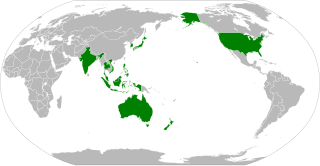
The Indo-Pacific Economic Framework for Prosperity (IPEF) is an economic initiative launched by U.S. President Joe Biden on May 23, 2022. The framework launched with fourteen participating founding member nations in the Indo-Pacific region with an open invitation for other countries to join.



